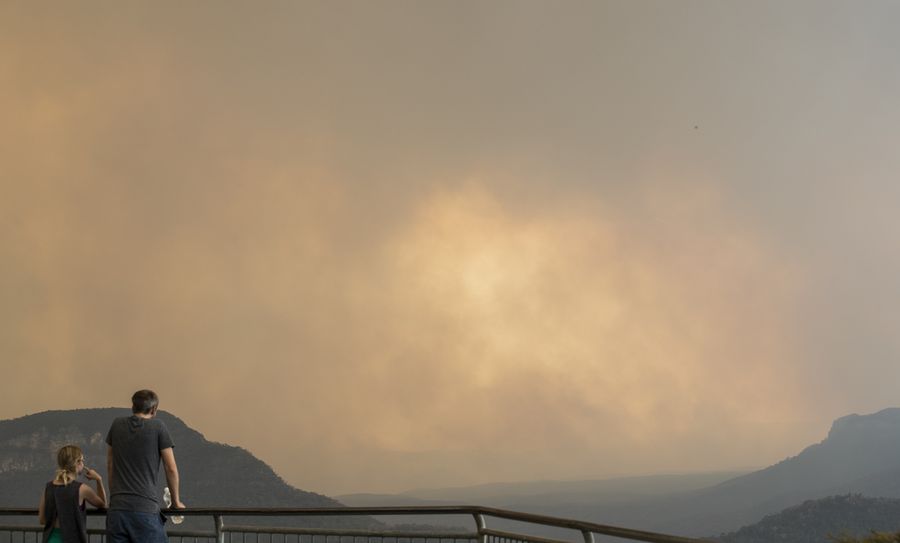
Citizens observe the condition of the bushfire in the smoke-shrouded Blue Mountain area, New South Wales, Australia, Dec. 21, 2019. (Xinhua/Bai Xuefei)
Australia's bushfire was reignited by soaring temperatures and strong winds in four states on Monday. The bushfire has killed nine people and destroyed around 1,000 houses so far.
by Duncan Murray, Levi J. Parsons
SYDNEY, Dec. 30 (Xinhua) -- Extreme weather reignited the bushfire crisis across Australia on Monday, with emergency warnings in four states as soaring temperatures and strong winds fanned infernos.
Wind gusts of above 100 km/h battered southeast Australia while temperatures over 40 degrees Celsius made firefighter's task extremely difficult.
"Elevated fire danger is being driven by exceptional heat and strong, even damaging winds making their way from the interior of the country," Bureau of Meteorology scientist Jonathan How explained.
Around 30,000 people in the Victoria State region of East Gippsland were told to evacuate as out of control fires threatened communities there.
Popular with hikers, campers and families, especially during the Christmas holiday period, the area in Gippsland Valley affected by bushfires is over 15,000 square km.

Citizens observe the condition of the bushfire in the smoke-shrouded Blue Mountain area, New South Wales, Australia, Dec. 21, 2019. (Xinhua/Bai Xuefei)
A cool change predicted for Monday afternoon threatened to make the situation even worse, bringing gustier winds and the chance of thunderstorms.
"This will continue to create dangerous conditions for the fires beyond today, so with hazardous weather set to impact the southeast during this busy holiday period, it's vital to keep yourself and loved ones safe," How said.
Overnight a fire in eastern Victoria emitted a 14-km-high pyrocumulonimbus cloud which resulted in lightning strikes.
The possibility of "dry thunderstorms" was also worrying officials in the State of South Australia (SA), where lightning strikes had already started several fires.
The mix of heat, wind and thunderstorms created catastrophic conditions for SA firefighters, with fires ravaging the popular wildlife sanctuary of Kangaroo Island, as well as the hills west of State capital, Adelaide.

Combo photo shows the Blue Mountain area before (top, taken on May 15, 2019) and after the bushfire (bottom, taken on Dec. 21, 2019) in New South Wales, Australia. (Xinhua/Bai Xuefei)
In the state of Western Australia, a giant fire in the goldfields region has burnt through 148,000 hectares since it began on Dec. 16, posing a risk to lives and property, while another fire which started on Boxing Day took around 200 firefighters to keep it contained.
Meanwhile, in the state of New South Wales, fires continued to rage west of Sydney and once again covered the city in dense smoke.
The national capital of Canberra cancelled it's New Year's Eve fireworks due to risk of fire and some members of the public called on Sydney to do the same. However, organisers said that the iconic celebration, centering on the Harbour Bridge, will go ahead as planned.
Instead, viewers both in Australia and overseas will be encouraged to donate money to charities for victims of the fires.
"People across Sydney and Australia have been deeply moved by the scale of losses with the recent spate of bushfires, and it has inspired extraordinary acts of kindness and an outpouring of support," Australian Red Cross acting director NSW/ACT, Annie Harvey said.
So far this bushfire season an estimated 1,000 homes as well as nine lives have been lost, including those of two volunteer firefighters. ■



